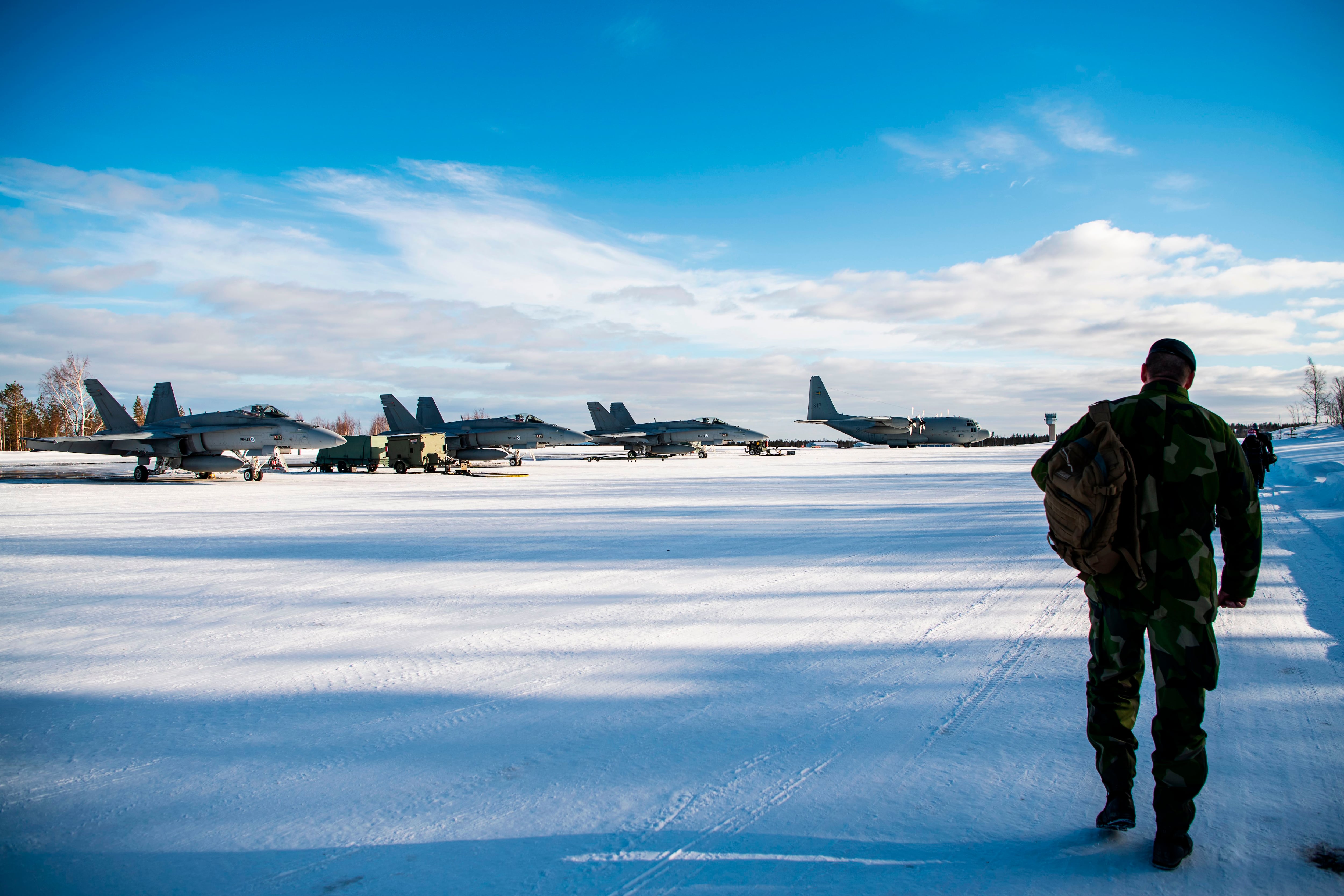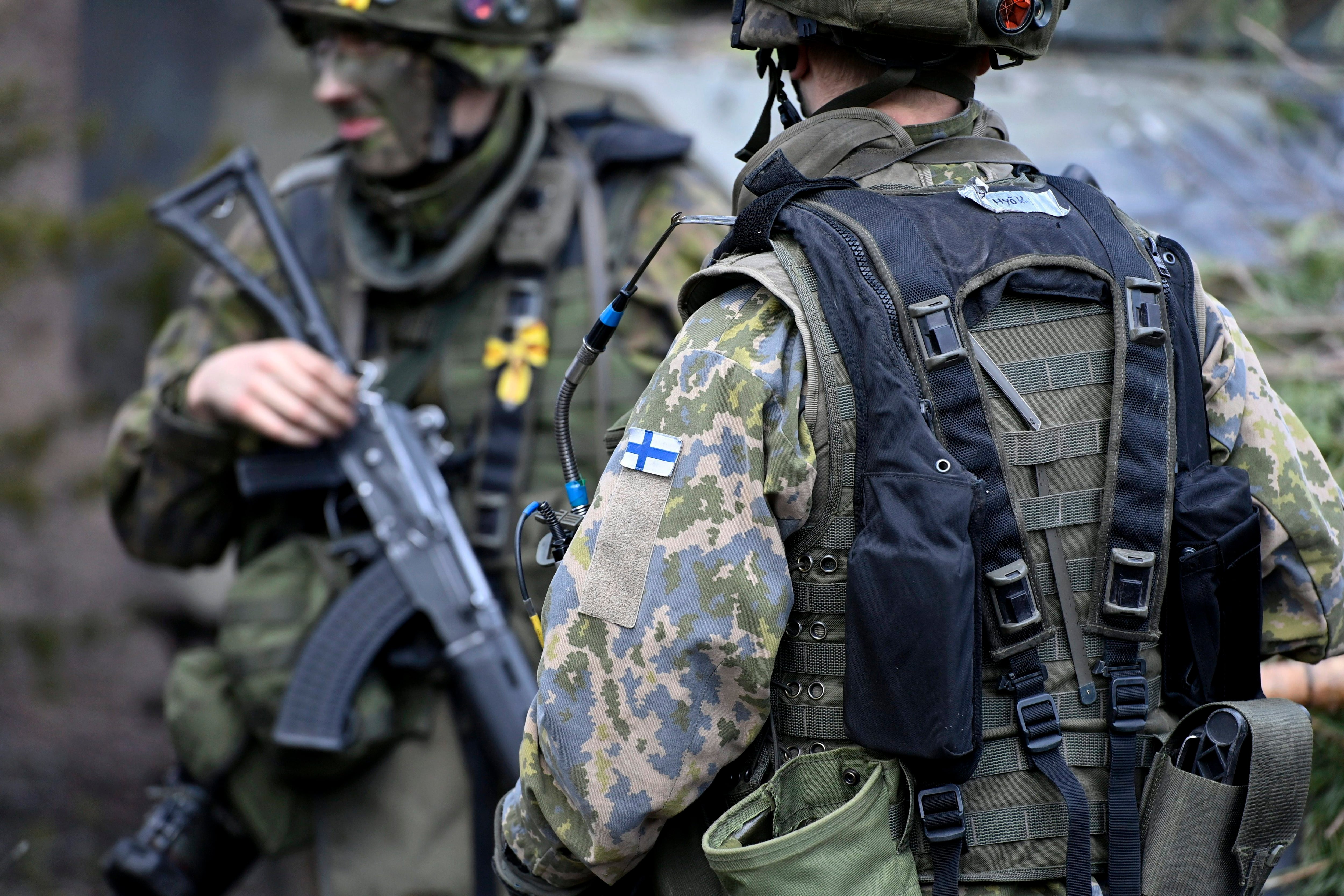STOCKHOLM ― With the decks of the massive amphibious assault ship Kearsarge loaded with MV-22 Osprey and AH-1 Cobra rotary-wing aircraft, U.S. Marines and allied forces were getting ready to retake islands from a fictional aggressor in a war exercise showcasing allied firepower in Northern Europe.
The NATO exercise BALTOPS – to be held on the Baltic Sea next week – is the latest showing of unity and military strength as Sweden and Finland trade neutrality for NATO’s embrace in the wake of Russia’s three-month-old invasion of Ukraine.
Journalists were invited aboard the 844-foot Kearsarge, whose port visit marked the first time a U.S. naval vessel of its size has visited Stockholm, for a press conference with U.S. Gen. Mark Milley, the chairman of the Joint Chiefs of Staff, as well as Swedish Prime Minister Magdalena Andersson, and the Swedish military’s top civilian and uniformed leaders.
Roughly 7,000 troops, 45 ships and more than 75 aircraft from 14 NATO allies, plus Sweden and Finland, are taking part in the alliance’s 51st annual BALTOPS exercises.
Andersson said the drill was “a strong signal to the world” that U.S. President Joe Biden’s security assurances, expressed when she and Finnish Predient Sauli Niinistö met him at the White House in May, “is actually followed with concrete action ... and for this we are very very grateful.”
While membership in the mutual-defense alliance would provide new security for Sweden, Andersson said Sweden and Finland “want to be security providers and provide strong security for our part of the Baltic region.” Sweden, she said, would be ready to stand behind NATO’s mutual defense agreement, known as Article 5.
For his part, Milley praised Sweden and Finland’s interoperability and intelligence sharing with NATO allies, and modern military capabilities. He also said their strategic locations would limit Russian military adventurism.
RELATED

With Finland and Sweden’s NATO membership, which is still pending, the famously shallow Baltic Sea would be surrounded almost exclusively by alliance countries, with Russia maintaining its access through naval sites in Kaliningrad in the south and the St. Petersburg region at the far eastern end.
“So from a Russian perspective that would be very problematic for them, militarily speaking, and it would be very advantageous to NATO,” Milley said. “The Baltic Sea is a very important area strategically, but the purpose of the alliance is not offensive, its purpose is defensive.”
Over the next few days, U.S. Marines will rehearse their core task, an amphibious assault, against enemy beachheads on nearby islands. With Russia’s Baltic Sea fleet based in Kaliningrad 300 miles away, Russian seizures of neighboring islands is a scenario Sweden fears and prepares for.
On Saturday, reporters accompanied Milley on a tour of the Kearsarge that highlighted how its forces would perform an amphibious assault. The ship or any of the rotary wing aircraft from its massive flight deck could bombard an enemy beachhead with ordnance before Marines would make an amphibious landing.
A Marine Cobra pilot, Capt. Ryan Mortensen, told Milley his helicopter was armed with sidewinder missiles that have a two-mile range, air-to-ground 2.75-inch unguided rockets and a 652-round Gatling gun. Mortensen, whose job is to “clear out the zone” before the ship’s Ospreys will land assault troops, said he can communicate easily with allied troops.
“We have two radios, and we’ll be speaking with other forces from our armed allies on a common frequency, talking directly to personnel who are controlling fires from the ground, clearing us hot,” he said. “Foreign nations have joint tactical air controllers and they’ll be calling in fires.”

Interoperability takes practice, though. Transiting into the Stockholm harbor was tricky, with sometimes less than 10 feet of water under the Kearsarge’s keel. Steering the ship, whose pilot house is off-center to accommodate its flight deck, meant three Swedish mariners had to visit the ship a week in advance to practice steering it into port.
“That’s probably the most difficult transit we’ve done,” said Tera Geoffroy, a Navy lieutenant junior grade aboard the ship.
All NATO members must approve the two Nordic nations’ bids to join the alliance, which were propelled by Russia’s invasion of Ukraine. Turkey has said it won’t allow their accession unless certain steps are taken, raising questions about the actions NATO allies will take with Finland and Sweden as negotiations drag on.
Andersson told reporters Saturday she’s spoken with Turkey’s president, Recep Tayyip Erdogan, as part of a dialogue over Turkey’s concerns that Sweden harbors Kurdish groups Turkey considers terrorists, and she defended Sweden’s laws as tough on terrorists.
Meanwhile, uptick in exercises is already in the works. U.S. President Joe Biden and Defense Secretary Lloyd Austin are having U.S. European Command work with NATO to “develop options to modestly increase” previously planned drills, Milley said.
“We’re looking at things that we can do on the ground, with either Marines, or Army. There are things we can do with special operations forces, things we can do with air or maritime forces,” Milley said.
Meanwhile, Swedish Defense Minister Peter Hultqvist said aboard the Kearsarge that a series of planned multinational exercises with naval and air elements will send a strong signal that Sweden is willing to act with its friends.
“I see a future here with a lot of exercises that makes our part of Europe more secure and can fulfill what we need during this time of sensitivity, from now and until we are full members of NATO,” he said.
RELATED

Already, the Kearsarge is one of a number of U.S. ships that have sailed to European waters since Russia’s invasion of Ukraine.
Part of the Kearsarge Amphibious Ready Group, it deployed from Naval Station Norfolk on March 16 with elements of the 22nd Marine Expeditionary Unit, meant to serve as a multi-mission “sea-based, expeditionary crisis response force,” the Navy said.
The Kearsarge and other ships have been participating in international drills in the Baltic Sea region and elsewhere in Europe for more than a month, aimed at showing allied interoperability and high-end maritime warfare capabilities.
On a single day in late May, the Kearsarge was in Talinn, Estonia, while the guided-missile destroyer Paul Ignatius was in Haakonsvern, Norway; the destroyer Gravely and amphibious dock landing ship Gunston Hall were in Helsinki; and the guided-missile destroyer Jason Dunham was in Durres, Albania, according to 6th Fleet, which is headquartered in Naples.
While in Talinn, the Kearsarge and elements of the 22nd MEU drilled in the Estonian-led Siil exercise – “a multi-day, force-on-force exercise, as well as the execution of a vertical assault raid,” according to the Navy – that took them to about 15 miles from the Russian border, to the town of Võru.
It participated in exercise Northern Viking 2022 in Keflavik, Iceland, on April 2, with the Gunston Hall and amphibious transport dock ship Arlington. With France, Germany, Iceland, Norway, Portugal and the UK, they practiced amphibious landings, search and rescue, and humanitarian assistance operations.
From there, the Kearsarge made two port visits to Tromso, Norway, 217 miles north of the Arctic Circle. The ship crossed the Arctic Circle on April 7, which was a challenge because of the weather, its commanding officer said in an update to families of its crew, posted to Facebook late last month.
“Operating there was tough, The weather changed in seconds. Often it felt like the weather came up out of the ocean all around us. We spent a lot of time in low visibility, with low cloud cover, in fog and blizzard-like conditions,” Capt. Tom Foster said in the note. “Learning how to operate safely with our NATO parters was the mission, and we executed.”
Joe Gould was the senior Pentagon reporter for Defense News, covering the intersection of national security policy, politics and the defense industry. He had previously served as Congress reporter.






